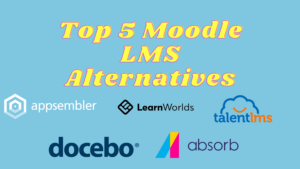On a recent SlashData podcast titled, “Developer Education & Enablement,” Appsembler’s CEO, Nate Aune, and Shannon Bradshaw, Education Partner at Unusual Ventures, recently discussed what venture capitalists (VCs) think of the developer education category and its market opportunity. The entire podcast is worth the listen, but if you’re short on time, read about the 8 key takeaways below.
#1: Venture Capital Cares About Developer Education
According to both Aune and Bradshaw, VCs are already investigating or investing in developer education. Both Aune and Bradshaw discussed how VCs are now realizing that developer education can be an effective strategy to educate developers about what a product does, how it works, and how it adds value. Many companies, for example, are building educational programs that give developers the content they need in the language they speak.
Bradshaw explains that within software companies:
“Developer education sometimes lives within a customer success organization, sometimes it lives within engineering, sometimes it lives within product, but in all, I see evidence of their investors and their leadership being extremely interested in developer education across the software industry in a variety of different domains like enterprise software, SaaS products, etc.”
Shannon Bradshaw, Education Parter – Unusual Ventures
VCs care about developer education — and are investing in it — because developers are becoming increasingly influential within organizations and are driving more technology purchase decisions. Software purchases that were top-down and driven by the C-suite are changing to be bottom-up and decided by end users.
Aune explains, “Nowadays, software is purchased much more from the bottom up. It’s developers getting in, trying out the software. And then they make a recommendation to the decision maker and say, ‘Hey, we’ve been running this thing through its paces. We’ve done a POC. We believe that this is the product that’s going to work for us.’ So if you’re a VC, and you’re trying to make your portfolio company successful and your company is making a software product for developers, you better believe that developer education is going to be a really key part of your strategy because, without it, you’re going to have a very hard time getting developers to recommend.”
Bradshaw explained that this is the model that they use at MongoDB:
“We’re focusing on the developer experience, obsessing over it really, because when you win the minds of developers, they’re going to agitate internally for adoption. Most go-to-market strategies nowadays for organizations are following a bottom-up strategy.”
#2: Developer Education vs. Developer Enablement
In the podcast, Aune spoke about the distinction between developer education and enablement. In short, developer enablement is the effort of ensuring that developers are successful with your product, whereas developer education is the body of knowledge that teaches them how to use your product.
Developer education can help with demand generation where you provide educational content to the industry you operate in. For example, when you create new technology that isn’t mainstream (yet), an educational experience can build awareness for it. Educational experiences build awareness because before you can get people to purchase your product, you need to educate them on the problem that your product solves, what the problem is costing them, how your product is helping other users, and the limitations of current solutions or processes.
Aune explains, “Once they’ve become a customer and they’ve bought the product, that’s what we typically think of as developer enablement. But developer education is priming people to be receptive to your product and understanding why they would adopt it in the first place. It is about helping people understand the value of the technology space that you’re in and that you’re creating. And that [developer education] is something that can help drive growth. It’s very hard to get someone to buy your product if they don’t understand why they would use it. And so a lot of education is just helping people understand the why, not just the what.”
#3: Metrics and Analytics are Crucial
VCs and software companies are trying to measure the effectiveness of developer education in driving product adoption, revenue and retention. These metrics include how many people are enrolling in a course, how many people are completing those courses, and how is that educational journey affecting product adoption?
Aune explains, “So this is both pre-sales like before they become a customer, as well as after they become a customer. Are they continuing to learn about the product and how is that product adoption proliferating throughout the organization? Is it just a small group of people or is it spreading? Are there more people at the organization who are adopting it?”
#4: Traditional Marketing Campaigns Don’t Work
It’s also important that once you get a developer learning about the product, they keep coming back for more. You need to keep them engaged and excited and encourage them to tell their coworkers about it. Traditional marketing campaigns typically don’t work in this scenario, although Chef Software (see webinar below) has succeeded in combining traditional marketing with developer education.
“Nowadays, software is purchased much more from the bottom up. It’s developers getting in, trying out the software. And then they make a recommendation to the decision maker.” – Nate Aune, CEO of Appsembler
Developers and software engineers don’t like to be marketed to, but they are lifelong learners. They love to learn about new technologies, so sending them a reminder of a course they started is an effective way to keep them engaged with your product.
According to Aune, a lot of Appsembler’s customers have moved beyond traditional marketing email campaigns and now use developer marketing-based nurturing campaigns to remind them of the learning experience, what they signed up to learn about, and when their homework is due. In fact, Chef Software’s marketing team figured out a way to personalize and target traditional marketing campaigns to increase the amount of product-related courses that their developer community took.
Aune elaborates that, “Those emails get very high open rates compared to a traditional marketing email because it’s all about learning. It’s all about education. It’s all about helping you to grow in your career and become a better developer. So that’s one of the things that I think is so important to measure is the engagement of those developers. After that initial spark, do they keep coming back? And are they enrolling in more intermediate or more advanced courses after they take those initial quick-start type experiences?”
MongoDB has already successfully used these kinds of educational email marketing campaigns. According to Bradshaw:
MongoDB had a 60% click-through rate for emails that promoted MongoDB’s learning experiences.
Bradshaw explains, “We had a report that we would produce weekly called the smoke report — coming from the idea of where there’s smoke, there’s fire — and a major component of that was looking at the registration or other forms of engagement data that we were tracking for MongoDB University and looking for clusters of individuals who all had the same email address domain.”
If there was interest from multiple people within the same organization, that was a signal that they needed to reach out. MongoDB would then talk to that organization about either providing services or an initial subscription.
“Paying attention to what that data is telling you is one of the strongest ways to get a sense of the degree of interest within a prospective organization,” says Bradshaw.
#5: Developer Education is An Opportunity for Open Source Software Companies
Open-source software companies optimize for ubiquity. They want to get their software to as many people as possible with the expectation that a percentage of the people using the open-source version will want commercial support. The problem with that is how do you connect with that anonymous developer who downloaded your software?
Aune gave the example at Redis, who uses Appsembler for developer education. They had 1 billion downloads of their software, but they didn’t have these users’ contact information and had no idea who they were. So if you’re the CMO of Redis, the first question you’ll ask is, who are all these people? Redis had no way of making a connection with the anonymous developer who downloaded their software.
“Developer education is priming people to be receptive to your product and understanding why they would adopt it in the first place. It is about helping people understand the value of the technology space that you’re in and that you’re creating. And that is something that can help drive growth.” – Nate Aune, CEO of Appsembler
To solve this problem, they created the Redis University where they reached out to Redis developers and invited them to take free courses. In exchange for getting these free courses, the developers needed to register and provide an email address. Once Redis had those email addresses, it opened up many possibilities, including looking for clusters of users who worked at the same company. These clusters were then passed to Redis’ sales team, which signaled an account with high purchase intent.
#6: Education is a Form of Customer Discovery
The act of educating your customers and prospective customers about your product is a form of customer discovery. It’s about shaping your product to meet your customers’ true pains and problems, not what you think they have.
According to Bradshaw, companies that roll out a developer education portal create a community that develops around their product. You can then use this community to find champions who will be evangelists for you within their own networks, or clusters of users who might represent commercial opportunities. As Bradshaw put it:
“It’s a way of magnifying the educational offering that you’re providing by having your community team really tap into… the community that’s already there and active around the learning resources you’re providing.”
Aune also explained how product courses help to drive product roadmap and increase a company’s understanding of its customers, “The act of creating educational content helps you to refine your ideal customer profile. It helps you to refine the messaging and how you can provide value to that customer. Something that we’ve heard from our customers is that they’ve learned more about their product and what its strengths are, what its weaknesses are, where it adds value by creating training and educational course content around that product. As you get new people coming in and adopting your product, you learn all the things that are missing, or the gaps in your product, and you learn more about your customers in the process.”
#7: Software Education Has Moved Online
One way that both Aune and Bradshaw see developer education advancing is its training delivery model. Software education was already moving online, but the pandemic accelerated that.
Developers and other end users are now expecting that learning experiences will be available in their own time. They want bite-sized, just-in-time learning as opposed to more formal experience where they need to take several days off to go to a training facility or attend a lengthy instructor-led training course.
Instructor-led training won’t go away entirely, but there will be a hybrid model where software learners can sign-up for instructor-led training or hands-on, self-paced courses.
#8: Why More Venture Capital Is Coming to Developer Education
Developer education strategy is increasingly influencing VCs because of the importance of user experience. Throughout every stage of building a company, you have to learn from your users, understanding what they are going to find most valuable, and what is going to bridge that gap to an experience that is much better than the one they currently have.
“It’s important to learn from your users through their experience with your documentation and your other educational offerings that play a fundamental role in helping you build your company,” says Bradshaw.
Both the product and your educational offerings are fundamental in helping you understand how you can reach your audience. If your tutorials, which make your community aware of your product’s features and how it solves their pain points, aren’t resonating with your audience, then there’s a disconnect between the educational content your building and what your users expect from it.
Bradshaw explains, “That is a very strong signal that you need to take a closer look at what pain you think you’re solving for users and who you believe your users are, and evaluate, are we trying to solve the right problem here?”
Creating educational content that matches the needs of your developer audience is crucial for every phase of building a developer-first, software product.
“Having a strategy for building your company that is focused on the developer experience is something that is incredibly important to those that you’re getting investment from,” says Bradshaw. “They need to see that you have that kind of focus if you’re going to hit your milestones and set yourself up for your next round of fundraising.”



